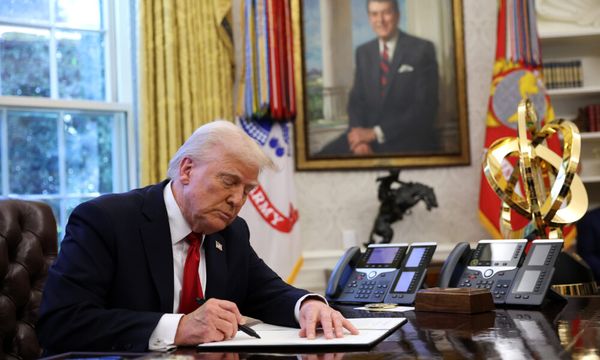
Kamala Harris's first speech outlining her economic policies did not bode well for business. In Raleigh, N.C., a week before the convention where she officially became the Democrats’ nominee for president, her language sounded bellicose: She boasted that as California’s attorney general she “took on insurance companies and Big Pharma,” that she “went after companies that illegally increased prices,” and that as president she would “attack” the high cost of health care and crack down” on unscrupulous corporate landlords. In that speech and many to follow, “big banks,” “Wall Street,” “corporations,” and “middlemen” were the liberal version of red meat—dirty words thrown out to elicit loud boos.
Yet while Harris’s public rhetoric does little to win over businesspeople, she is attracting the support of many of them. The language in an endorsement letter signed by 90 prominent business figures shows clearly why: her predictability, compared with her erratic opponent.
The letter oozes with implied disdain of Donald Trump and asserts that electing Harris is the best way to support “reliability” and “stability.” The signatories, which included tech founders and media moguls, as well as executives from the banking, investment, insurance, and pharmaceutical industries, offered a bottom-line rationale for Harris in the White House: “The business community can be confident that it will have a President who wants American industries to thrive.”
Those tycoons can’t be thrilled by Harris’s robustious promotion of higher taxes for richly paid individuals like themselves. Her lack of private-sector employment in her career may worry them. But as one signatory—a high-level Wall Street executive—tells Fortune, “Even those whose tax bills may be increased [in a Harris administration] recognize the impact on the American economy is going to be materially negative in a Trump scenario.”
For the Harris campaign, being less objectionable than the alternative may be enough to put her over the top in November. But if she is elected and finds herself steering the government’s relationship with business, she may find that being the lesser of two evils is not a particularly strong position.
Harris praises the “Bidenomics” of the administration she’s now a part of, and has often said that “by virtually every measure, our economy is the strongest in the world.” But CEOs can be a tough audience—and they certainly aren’t cheering. In the Conference Board’s latest survey, big-company CEOs are barely above the line separating optimism from pessimism. Small-business owners are even less upbeat: The National Federation of Independent Business reports that optimism is “in the dumps.” Meanwhile, 63% of Americans say the economy is on the wrong track.
Against that backdrop, Harris’s first economic promise—exempting tips from taxation—was canny. It copied a Trump promise that appeals to America’s 2.3 million waitstaff and also to restaurant owners.
Her other early high-profile promise, to pursue “the first-ever federal ban on price-gouging on food,” backfired. Economists, including economic advisers from the Clinton and Obama administrations, quickly denounced the proposal because price restrictions would likely make shortages worse. Harris has rarely mentioned the price-gouging ban in recent weeks.
Harris now seems to be gaining her footing on economic policy. But many Americans are still left with a simple, vital question: What would President Kamala Harris do?
Kamala Harris on taxes
The most consequential fight over economic policy in 2025 will center on the Tax Cuts and Jobs Act (TCJA), which expires at year-end. This massive law, enacted under Trump in 2017 with no Democratic votes in the House or Senate, rewrote the tax rules for individuals, small companies, and big companies.
At least one key element, the tax reduction for the 97% of American households earning less than $400,000 a year, could be extended with broad bipartisan support. “That would sail through with an enormous supermajority of both parties,” says Brian Riedl of the Manhattan Institute, a right-leaning public policy think tank focused on economic policy. “The debate is what to do about those earning over $400,000.” Democrats have campaigned heavily on the claim that “Trump cut taxes for billionaires,” so it’s hard to imagine a President Harris signing an extension of the cut—even though many businesspeople earning $400,000 to $700,000 don’t feel like plutocrats.

Harris has endorsed the Biden proposal to raise the corporate tax rate from 21% to 28%. That would still be much lower than the 35% rate before the TCJA, but “when including state taxes, it would be the second highest corporate tax in the OECD,” Riedl says, and because of other changes in tax rules, companies would face “a significantly higher overall corporate tax burden than before the 2017 tax cuts.”
The nonpartisan Committee for a Responsible Federal Budget (CRFB) estimates the tax hike would increase federal revenue by $1 trillion over 10 years, but mustering the political will to enact her full corporate tax program could be difficult, even if she has a Democratic Congress.
Harris also endorses President Biden’s proposed tax on unrealized capital gains for individuals with a net worth of over $100 million, which the CRFB estimates would bring in $500 billion over a decade, and Biden’s proposal to hike the tax on corporate stock buybacks from 1% to 4%, which the CRFB estimates would bring in $150 billion over a decade. She breaks with Biden on his proposed 39.6% tax on realized capital gains for households with taxable income over $1 million; Harris favors a 28% rate. (The current rate is 20%.) Those taxes also would be tough to enact in full.
More broadly, Harris has endorsed Biden’s Budget of the U.S. Government, which the president must propose every year. The latest version, 188 pages, would increase taxes by $5 trillion over the next decade, growing slightly faster than predicted GDP.
Kamala Harris on regulation
By the calculations of the American Action Forum, a center-right think tank that has tallied the costs of federal regulations for each year since 2005, the Biden administration has set a record. “It has imposed $1.7 trillion of regulatory costs on the private sector,” says Douglas Holtz-Eakin, AAF’s founder and a former director of the Congressional Budget Office. By comparison, “Obama did $870 billion in two terms.”
The most vigorous regulator of the past four years has been the Federal Trade Commission and its polarizing chair, Lina Khan, who is trying to break up Amazon and wants to block the merger of grocery giants Kroger and Albertsons. At least 19 deals have been abandoned after the FTC filed challenges.
This hasn’t just frustrated business leaders who support Trump; major Harris donors, including media executive Barry Diller and LinkedIn cofounder Reid Hoffman, want Harris to fire Khan.

But whether or not Khan remains in a Harris administration, the FTC would likely continue on a similar track, says Heidi Shierholz, president of the left-leaning Economic Policy Institute. Harris may even widen the FTC’s remit. With voters still experiencing sticker shock at the grocery store, Shierholz says, “I think one of the ways she will address price increases is through the antitrust route”—by blocking the Kroger-Albertsons merger, for example.
Kamala Harris on tariffs
During the September Harris-Trump debate, Harris said, “My opponent has a plan that I call the ‘Trump sales tax,’ which would be a 20% tax on everyday goods that you rely on.” Few viewers would have guessed she was talking about Trump’s proposal to impose a tariff as high as 20% on all U.S. imports.
Indeed, tariffs rarely play a role in retail politics—until they do. That’s what happened when President Trump launched a trade war by imposing tariffs on several major countries, notably China.
Harris described this accurately: Tariffs are indeed a tax on the people and businesses of the importing country, in this case the U.S.—but she made no mention of the Trump tariffs the Biden administration kept. In fact, the Biden administration has kept nearly all of Trump’s tariffs, increasing some and adding more, mostly on Chinese imports.
Harris has said little more than this about tariffs. But de-escalating a trade war isn’t easy, and she has shown no particular intention to do so. A spokesman for the Harris-Walz campaign has said she will “employ targeted and strategic tariffs to support American workers, strengthen our economy, and hold our adversaries accountable.”
Kamala Harris on housing
Millions of Americans can’t afford the home they would like, in large part because so few homes are for sale, and scarcity has driven up their prices. That’s why Harris has made housing one of her key issues. It’s the problem she aims to solve with one of her boldest promises: “By the end of my first term, we will end America’s housing shortage by building 3 million new homes and rentals that are affordable for the middle class.”
Like her price-gouging proposal, this one has its skeptics. As well as offering builders a tax break to build starter homes, her plan includes a $25,000 tax break to help first-time homebuyers with the down payment on a new home. Economists have quickly noted that the subsidy would increase demand and could push home prices up. In addition, three days after she introduced her affordable-housing program, the Biden administration nearly doubled tariffs on imported Canadian lumber, pushing up construction costs.
Her supporters point out that the incentives for homebuilders would increase supply, countering the program’s stimulus to demand—“a nice kind of one-two punch,” says EPI’s Shierholz. But Riedl and others point out that in many localities the main impediments to low-cost housing are ordinances and zoning codes, “which are unlikely to be fixed by federal policy.” He worries that “we’ll get the higher demand without increased supply,” which would push home prices upward.
Harris’s running mate, Minnesota Gov. Tim Walz, has supported several changes, including revised local building codes and zoning, that have increased housing supply and slowed rent increases in his state.
Kamala Harris on the federal debt
This will be the No. 1 issue facing the next president, but it’s also the issue no candidate wants to talk about. Profligate overspending is a bipartisan habit. The national debt held by the public was $14.4 trillion at Trump’s inauguration and $22 trillion at Biden’s inauguration. It’s $28 trillion now, and Biden’s latest 10-year budget predicts it will reach $45 trillion in 2034. Interest payments have reached $1 trillion a year. That’s why the U.S. Government Accountability Office warns that the growing debt is unsustainable.
If elected, Harris could be the first president to confront debt doomsday.
Harris often says her proposed programs would “pay for themselves.” (So does Trump.) For example, she said in August that if the government increases the Earned Income Tax Credit and the Child Tax Credit, as she proposes, “The return on that investment, in terms of what it will do and what it will pay for, will be tremendous. We’ve already seen it when we did it in the first year of our administration, and it reduced child poverty by over 50%.” Those credits do improve lives and have bipartisan support, and they may pay off in longterm economic outcomes: Children may eventually get better jobs than they otherwise would have, for example. But increasing spending on most programs does not pay for itself in any sense the U.S. Treasury would recognize.
The looming debt crisis would be a massive problem in a Harris presidency. If she wins two terms, she could be the first president to confront debt doomsday. On the current trajectory, Social Security will be unable to pay full benefits starting in 2033, when her second term would end. The political conflagration, with Harris at its center, would be well underway by then, unless both parties mend their ways now—which they show no signs of doing.
Harris can’t be criticized on this issue more than any other presidential candidate. With all the talk of tax cuts and generous government programs, they all skip over the debt crisis—and voters aren’t demanding answers. The nonpartisan Penn Wharton Budget Model estimates that Harris’s policy proposals would increase the primary deficit, which excludes interest payments, by $2 trillion over 10 years; Trump’s policy proposals would increase it by $4.1 trillion.
A smaller increase is better, but either approach is pushing the country ever closer to a crisis.
Additional reporting by Alena Botros.
This article appears in the October/November 2024 issue of Fortune with the headline "Kamalanomics: Harris's road map for business."
More from the October/November issue of Fortune:
–See which companies made the 2024 Fortune Change the World list
–What the Fed rate cut means for investors
–Where Silicon Valley is spending its millions in political donations, charted
–Who has time for a power lunch? The real business happens at 4 p.m. ‘power hour’







